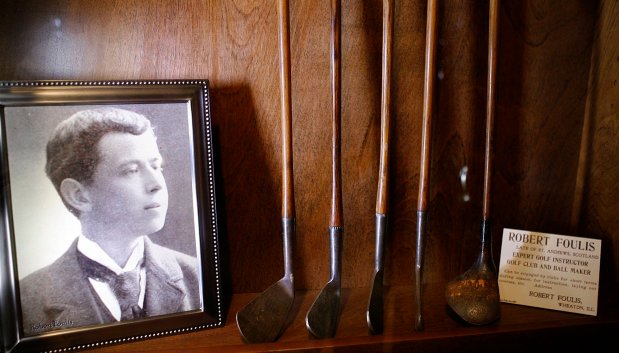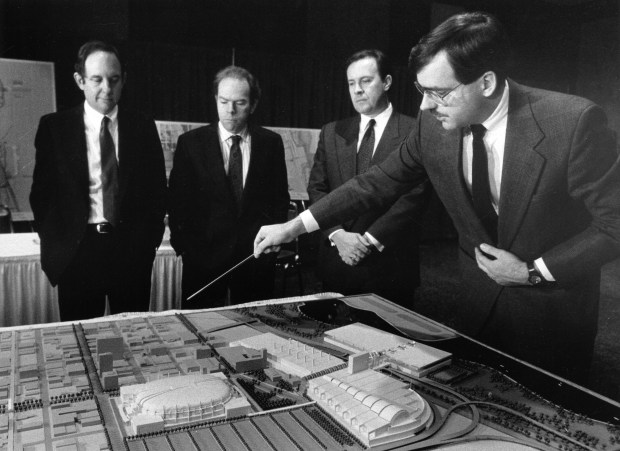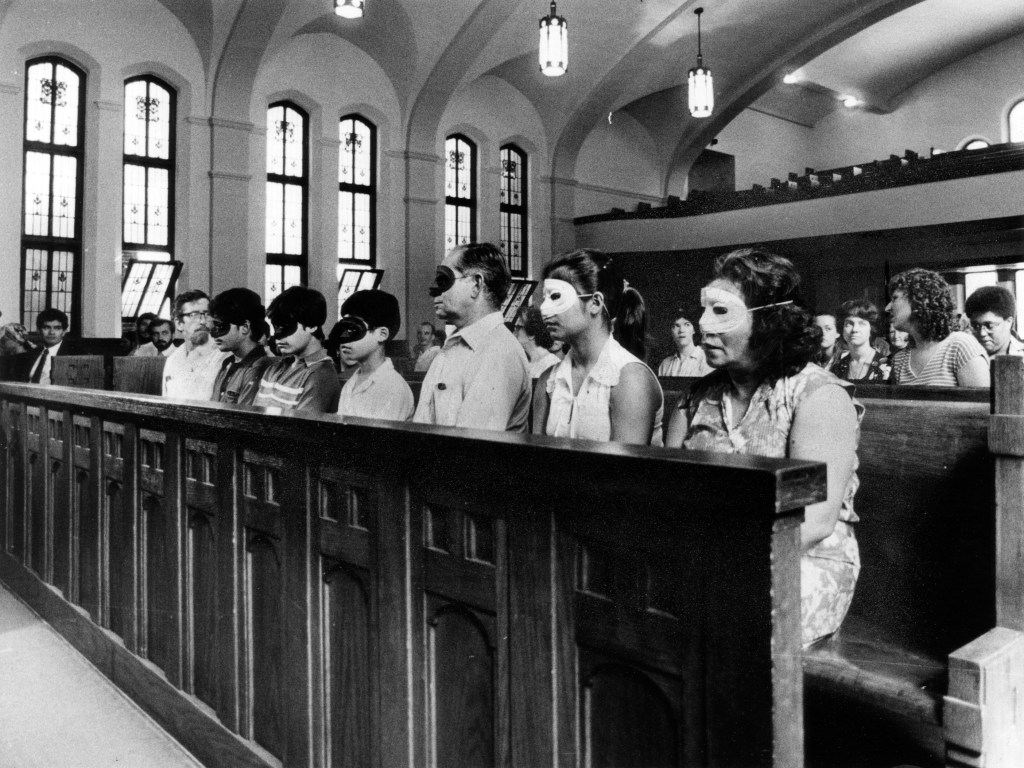Here’s a look back at what happened in the Chicago area on July 18, according to the Tribune’s archives.
Is an important event missing from this date? Email us.
Weather records (from the National Weather Service, Chicago)
- High temperature: 100 degrees (1946)
- Low temperature: 53 degrees (1979)
- Precipitation: 2.9 inches (1993)
- Snowfall: Trace (1992)
 A photo of and golf clubs made by Wheaton resident Robert Foulis, brother of U.S. Open winner James Foulis, in the “Fairways, Greens & Clubs” exhibit at the Wheaton Historic Preservation Council’s “Center for History” on Nov. 30, 2006. (George Thompson/Chicago Tribune)
A photo of and golf clubs made by Wheaton resident Robert Foulis, brother of U.S. Open winner James Foulis, in the “Fairways, Greens & Clubs” exhibit at the Wheaton Historic Preservation Council’s “Center for History” on Nov. 30, 2006. (George Thompson/Chicago Tribune)
1896: James Foulis, a native of St. Andrews, Scotland who became professional at Chicago Golf Club in Wheaton, shot 78-74—152 at Shinnecock Hills Golf Club on Long Island to win the second U.S. Open golf championship. Foulis’ prize was $200.
John Shippen, believed to be the first Black and American-born golf professional to play in the U.S. Open, placed fifth.
Foulis lost to Joe Lloyd in the third U.S. Open, which was held at Chicago Golf Club in September 1897.
 Refugees from war-torn El Salvador — including a young civil engineering student who went by the name of “Juan” — found safe haven inside the sanctuary of Wellington Avenue United Church, 615 W. Wellington Ave., Chicago, in 1982. (Chicago Tribune)
Refugees from war-torn El Salvador — including a young civil engineering student who went by the name of “Juan” — found safe haven inside the sanctuary of Wellington Avenue United Church, 615 W. Wellington Ave., Chicago, in 1982. (Chicago Tribune)
1982: The Wellington Avenue Church congregation voted to join the sanctuary movement — becoming just the second church in the United States to harbor refugees who entered the country illegally.
The movement, which had roots in the medieval tradition of churches providing sanctuary for those fleeing persecution, was aimed at providing a safe haven for Central Americans running from political repression and violence in their home countries. They were refused asylum here because of U.S. support for the governments of El Salvador and Guatemala. About 20 Chicago-area churches became sanctuaries in the 1980s.
 Kim Goluska, right, of Skidmore, Owings and Merrill, goes over a model of a new McCormick Place with the Metropolitan Pier and Exposition Authority’s John Schmidt, from left, Jim Reilly and Pat Daly. (Charles Osgood/Chicago Tribune)
Kim Goluska, right, of Skidmore, Owings and Merrill, goes over a model of a new McCormick Place with the Metropolitan Pier and Exposition Authority’s John Schmidt, from left, Jim Reilly and Pat Daly. (Charles Osgood/Chicago Tribune)
1991: Senators voted 31-23 to approve a nearly $1 billion plan to expand McCormick Place exhibition center to more than 1 million total square feet through a mix of convention-related taxes including city levies on hotels and meals within a restaurant taxing district, new fees on Cook County auto rentals and taxes on commercial rides to and from O’Hare and Midway airports. The House later approved the measure 65-44. Gov. Jim Edgar signed the legislation two months later.
In addition to the construction of a South Building, the plan also included revamping Lakeside Center, adding exhibition space to the North Building, creating a glass-enclosed concourse to link the entire complex and rerouting DuSable Lake Shore Drive to create the “museum campus” — the Field Museum, the Shedd Aquarium and the Adler Planetarium.
Vintage Chicago Tribune: How McCormick Place’s Lakeside Center came to be on the lakefront
Not included — a proposed $400 million domed stadium nicknamed “McDome,” which could have housed the Chicago Bears.
Ground was broken in 1993 and the South Building opened its doors to the International Housewares Show three and a half years later.
The McCormick Place complex now offers more than 2.6 million square feet of exhibition space, 600,000 square feet of meeting space and the 10,000-seat Wintrust Arena.
Want more vintage Chicago?
Subscribe to the free Vintage Chicago Tribune newsletter, join our Chicagoland history Facebook group, stay current with Today in Chicago History and follow us on Instagram for more from Chicago’s past.
Have an idea for Vintage Chicago Tribune? Share it with Kori Rumore and Marianne Mather at krumore@chicagotribune.com and mmather@chicagotribune.com
